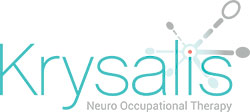Neuro occupational therapy in action: understanding symptoms for work readiness

Introducing Peter, a stroke survivor determined to return to work.
In his 50s, warehouse operative Peter was initially misdiagnosed with sciatica after experiencing severe pain down his right leg.
When his symptoms worsened, a subsequent MRI scan revealed that Peter had suffered three strokes in close succession.
Shocked by the diagnosis, and feeling the effects of his symptoms, Peter questioned whether a return to work would ever be possible; he wondered what was needed to get him work-ready.
The need
Once Peter had been correctly diagnosed, he underwent blood clot removal surgery to prevent further strokes.
After three months of community physiotherapy, Peter's symptoms were slowly improving, and he was discharged.
While this had meant he was making progress with his recovery, he knew he could not return to the job he loved without help and support.
Peter's insurer referred him to Krysalis for an assessment and a work readiness programme, following an eleven-month absence from work.
His role as a warehouse team manager was important to Peter, and he was eager to see if he could be ready for work again.
 Understanding Peter's neurological symptoms, and how they impact his daily function, were an essential part of the vocational rehabilitation process. I worked with Peter to assess and treat his symptoms at the same time.
Understanding Peter's neurological symptoms, and how they impact his daily function, were an essential part of the vocational rehabilitation process. I worked with Peter to assess and treat his symptoms at the same time. 
Krysalis neurological occupational therapist, Anna
The question
Neurological occupational therapist Anna was aware that Peter's strokes had caused him to experience memory difficulties, neurological fatigue, physcial coordination challenges, and reduced strength on his right side.
Peter did not understand his needs or symptoms, which made it difficult for him to request the adjustments he needed to succeed at work.
He also experienced unmanaged anxiety, reduced confidence, and feelings of guilt for relying on his wife for household chores.
Anna began to assess how the diagnosis and symptoms were impacting Peter's everyday functioning, in order to answer the hardest question of all: could Krysalis help Peter to be ready to work again?
Seeing the whole picture
At the point of assessment, Peter was found to have work-based skills, a supportive employer, and, importantly, the drive and motivation for work.
It was clear to Anna that encouraging Peter to build on his independence and skills at home, in a safe space to practice and learn about his abilities and symptoms, would be hugely beneficial.
 I enjoy everything about working. I just want to get back to doing something, being back at work, and being full time. It's very important to me.
I enjoy everything about working. I just want to get back to doing something, being back at work, and being full time. It's very important to me. 
Peter, at the start of his intervention
Anna highlighted the importance of consistency and how activities of daily living would help Peter to build his confidence, as well as his physical and mental strength.
Mobility exercises and an improved routine allowed Peter to prepare for work. This included walking longer distances without support and getting up early to replicate the workday routine.
Specialist support
Anna also introduced strategies such as grounding and self-regulation techniques, and discussed triggers for his neurological fatigue.
She helped Peter to identify his symptoms and challenges, and how they related to activities and the environment.
Anna educated Peter and his wife about stroke, neuroplasticity, and the connection between cognition and communication - all of which has a positive impact on Peter's confidence and sense of self.
 Following a stroke, it can be challenging for individuals to interpret their symptoms and recognise the barriers; my role was to help Peter understand his needs so he can share these insights with his workplace.
Following a stroke, it can be challenging for individuals to interpret their symptoms and recognise the barriers; my role was to help Peter understand his needs so he can share these insights with his workplace. 
Krysalis neurological occupational therapist, Anna
Did Peter become work ready?
After three months with Anna's guidance, Peter is now work ready and, more than ever, eager to return to his previous role.
This specialised intervention allowed Peter to gain a better understanding of his needs, how to manage his symptoms, and, importantly, how to achieve success at work.
A return-to-work date has been scheduled following discussions with his employer, and Anna will continue to work with Peter as he takes this next step.
Recently on talking heads...



